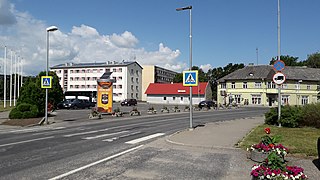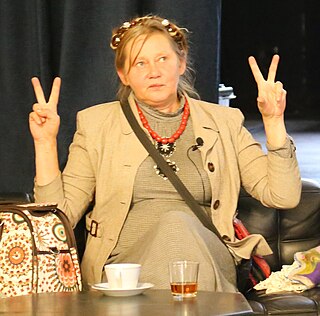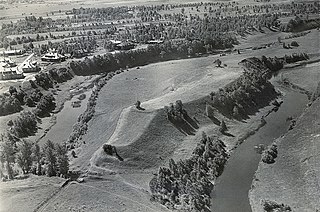
Tartu is the second largest city in Estonia after Tallinn. Tartu has a population of 97,435. It is 186 kilometres southeast of Tallinn and 245 kilometres northeast of Riga, Latvia. Tartu lies on the Emajõgi river, which connects the two largest lakes in Estonia, Lake Võrtsjärv and Lake Peipus. From the 13th century until the end of the 19th century, Tartu was known in most of the world by variants of its historical name Dorpat.

Tapa is a town in Tapa Parish, Lääne-Viru County, Estonia, located at the junction of the country's Tallinn–Narva (west–east) and Tallinn–Tartu–Valga (north–south) railway lines. It is an important centre of transit for freight as well as rail passengers, a home to soldiers since the 1930s. Tapa also plays an important role in training young men and women in the Estonian Defense Forces, being nearby to Keskpolügoon. The Valgejõgi River passes Tapa on its northeastern side.

Walter Arthur Alexander Anderson was a Baltic German ethnologist (folklorist) and numismatist.

Kalevi Keskstaadion is a multi-purpose stadium in Tallinn, Estonia. Opened in 1955 and having a capacity of 12,000, it is the traditional venue of the Estonian Dance Festival and the former home ground of JK Tallinna Kalev. The address of the stadium is Staadioni 8, 10132 Tallinn.

The Estonian Workers' Commune was a government claiming the Bolshevik-occupied parts of Republic of Estonia as its territories during the Estonian War of Independence and the Russian Civil War. It was recognised as an independent state only by Russian SFSR on December 7th, 1918.
The Korvpalli Meistriliiga (KML), known as the PAF Korvpalli Meistriliiga for sponsorship reasons, is the top-tier men's basketball league in Estonia. The league is organized by the Estonian Basketball Association.

Jüri Talvet is an Estonian poet and academic. He is the author of various literary works including poetry, criticism, and essays.

Estonia, officially the Republic of Estonia, is a country by the Baltic Sea in Europe. It is bordered to the north by the Gulf of Finland across from Finland, to the west by the sea across from Sweden, to the south by Latvia, and to the east by Lake Peipsi and Russia. The territory of Estonia consists of the mainland, the larger islands of Saaremaa and Hiiumaa, and over 2,300 other islands and islets on the eastern coast of the Baltic Sea, covering a total area of 45,335 square kilometres (17,504 sq mi). Tallinn, the capital city, and Tartu are the two largest urban areas of the country. The Estonian language is the indigenous and official language of Estonia; it is the first language of the majority of its population, the world's second-most spoken Finnic language as well as the third-most spoken Uralic language.

Peeter Järvelaid is an Estonian legal scholar and historian. Järvelaid is a professor in the University of Tallinn. He has developed semiotic and personality-centered research direction, writing hundreds of articles mostly about the European and Estonian legal history and education, published in Estonian, English, German, French, Russian, Latvian, Finnish, Lithuanian and Swedish. Since 2006 his studies have been increasingly concentrated on the international relations in the 20th century, which among others has required intensive archival researches in German and Polish archives. Since 2012 Järvelaid has placed his research emphasis on the German diplomatic missions, with a specific interest in German diplomatic representation in Tallinn.

Tullio Ilomets was an Estonian chemist, science historian and a volunteer in heritage protection.

Merle Jääger is an Estonian television, stage and film actress, poet and author who frequently uses the pen name Merca. Initially associated with the burgeoning Estonian punk rock scene of the early to mid 1980s, she has been described as the "bard of protest". Her career as an actress began in her early 20s and she has received a number of high-profile awards for stage roles.

The Viking Age in Estonia was a period in the history of Estonia, part of the Viking Age. It was not a unified country at the time, and the area of Ancient Estonia was divided among loosely allied regions. It was preceded by the Bronze and Early Iron Ages in Estonia, during which an agrarian society had developed, the Migration Period, and Pre-Viking Age with the Viking Age itself lasting between 800–1050 AD. It is often considered to be part of the Iron Age period which started around 400 AD and ended around 1200 AD, soon after Estonian Vikings were recorded in the Eric Chronicle to have sacked Sigtuna in 1187.
Kaur Alttoa is an Estonian art historian and cultural historian.
Kaarel Liidak was an Estonian agronomist, agriculture minister and politician, member and chairman of the National Committee of the Republic of Estonia from March to August 1944.

Eero Medijainen is an Estonian historian. He focuses on Estonian history in the 20th and 21st centuries and Estonian foreign politics.

Hagi Šein is an Estonian journalist, film director, screenwriter, professor, media pedagogue and former figure skater.

Mai Hinge Raud-Pähn is an Estonian-Swedish art historian, editor, and journalist. She was the editor-in-chief of the Swedish-Estonian magazine Rahvuslik Kontakt from 1987 to 2014. Raud-Pähn was honoured with the Order of the White Star from the President of Estonia for her significant contributions to history and art. She turned 100 in 2020.

Janika Kronberg is an Estonian literary scientist and critic.

Juhan Maiste is an Estonian art historian.

Enn Tarvel was an Estonian historian.

















